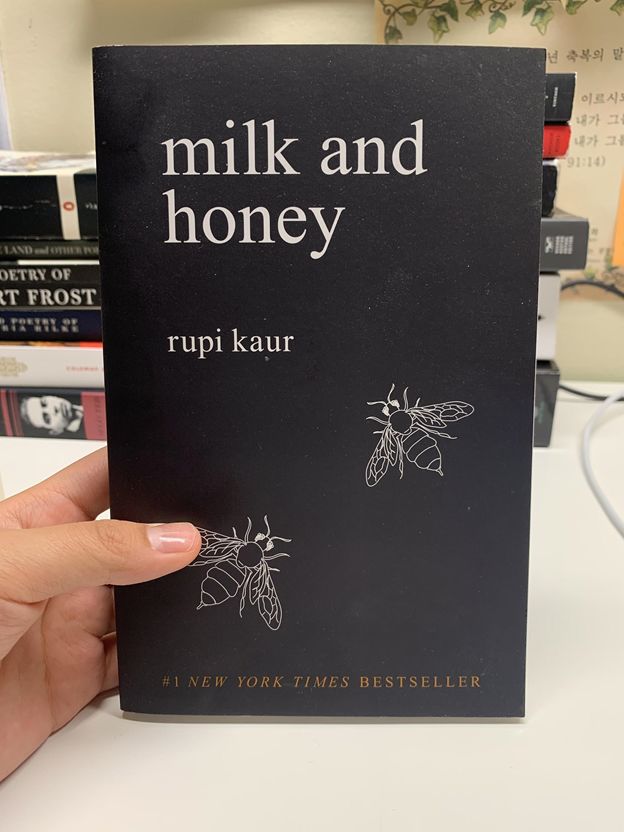[JSR] The Problem with “Instapoets” and the Deeper Implication Behind It

Rupi Kaur’s Milk and Honey, with its beautiful cover, is currently one of the best-selling poetry books.

Joyce Kim, Grade 10 La Canada High School
Poetry has always been a bold, expressive medium that is used to paint the poet’s thoughts, emotions, and reflections into art-like words. The works of great poets like Robert Frost, William Shakespeare, T.S. Eliot, Emily Dickinson, and Homer have become the foundation of our culture and its movements. But today, modern poetry has taken a turn for the worse, reduced into nothing but quick, shallow, artificial lines that leave nothing for the reader’s own interpretation. Typically following an excessively minimalistic format, these “Instapoems” seem to focus more on the aesthetics of an image rather than trying to get any sort of message across, tell a story, or provide extensive and thought-provoking content.
A prime example is Rupi Kaur’s Milk and Honey, probably the most well-known product of Instapoetry. One of the most successful books of 2014, it has sold over a million copies, helping the twenty-six-year-old poet amass nearly 4 million followers on Instagram. Such is a feat for any author, as it proves their ability to appeal to a greater audience and share insight that others find relevant and relatable. However, an interview with the author seems to suggest otherwise.
While browsing through a bookstore, Kaur stated, “I will always go into a used bookstore. I’ll collect a lot of covers that inspire me — whether it’s the paper inside, whether it’s a font, so then later I can be like, okay, how’s mine going to look?” Upon noticing a copy of Kafka’s complete stories, she goes on to state, “this guy is the best,” referring to Peter Mendelsund, the book’s designer. “The dream is to have him design my next book.” His work, she points out, translates well across media — to different sizes, to posters, to digital.
While an author is expected to treasure all facets of his/her book, it’s a given that the quality of the content should precede all the other aspects. Kaur’s neglect of her priorities as a poet clearly demonstrates the surface-level depth of her work, as she chooses instead to focus on how it’s going to look and dreams about getting it blown up to poster size. Not that she isn’t well-intentioned with her work— she is known for her criticism of stigma around femininity and delving into topics like rape and abuse— but her attention seems diverted from the basics of what we’d expect from any writer. Thus, we see the imminent problem with the foundation of Instapoetry: it lacks any sort of complexity that defines literature, and instead trades it in for a superficial simplicity and straightforwardness that appeals to the audience’s ignorance.
However, the problem with these Instapoets seems to be trifling. After all, at the end of the day, what does it matter that a couple million people double-tap on a couple words typed into a Stock photo of a bunch of flowers? But the phenomenon with Instapoets hints at an even deeper underlying problem: our generation’s addiction to images and our lack of true stimulation. More specifically, we are addicted to anything that we can glaze over in an instant, that gives us a sense of understanding and intelligibility. Evident through things like social media, Youtube, or even basic photography, we constantly bombard ourselves with these false realities in hopes of creating an ideal reality for ourselves, apart from what the world suggests. By nature, we attach ourselves to anything that can offer us reassurance, a sense of knowing something, rather than going through the trouble to seek things out for ourselves. Within this lies the true problem— at some point, we’ve become nothing but image-junkies that rely on being spoon-fed knowledge. And it is debatable whether the appeal of something as perfunctory and superficial as Instapoetry is one of the many causes or consequences of this problem.
That is to say, there isn’t anything wrong with enjoying these Instapoems— after all, it may be a source of inspiration for some. But at some point, there needs to be some sort of upgrade, like a level-up, within this search for knowledge and connection. It’s time for us to recognize our addiction to simplicity, and start challenging ourselves to actually think and strive for more than what just a couple shallow phrases, double-tap, and scroll gives us.










with the Korea JoongAng Daily
To write comments, please log in to one of the accounts.
Standards Board Policy (0/250자)